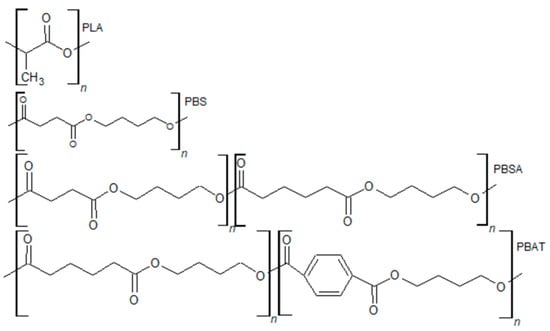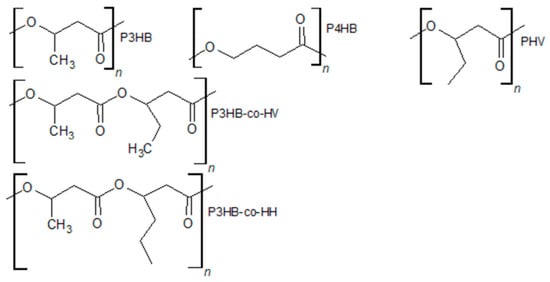You're using an outdated browser. Please upgrade to a modern browser for the best experience.
Please note this is a comparison between Version 1 by Corrado SCIANCALEPORE and Version 2 by Rita Xu.
Biopolymers obtained from renewable resources are an interesting alternative to conventional polymers obtained from fossil resources, as they are sustainable and environmentally friendly. Poly(lactic acid) (PLA) is a biodegradable aliphatic polyester produced from 100% renewable plant resources and plays a key role in the biopolymer market, and is experiencing ever-increasing use worldwide.
- biopolymers
- poly(lactic acid)
- polymer blends
1. Introduction
The exponential growth in global plastic manufacturing in recent years is a result of the rising world population, and is having a detrimental effect on the natural world and biodiversity [1]. As of 2020, there were 370 million tons of plastic items produced, up from a total of 1.5 million tons in 1950, and predictions show that by 2050, this percentage will have quadrupled [2][3][2,3].
Moreover, during the last 150 years, the industrial system has been based on a linear economic model involving the production of manufactured goods from fossil-based raw materials, their commercialization, utilization, and finally disposal as waste through incineration or landfill. As a result of the reduction in natural resources and the arising negative environmental impacts, this model is considered no longer sustainable for the future.
Nowadays, the production of most consumable items occurs using non-biodegradable traditional oil-based polymers, mainly polyolefins (polyethylene (PE), polypropylene (PP), polystyrene (PS)) and terephthalic-based polyesters (polyethylene terephthalate (PET)), leading to their accumulation in landfills or the Earth’s environment [4].
Back in 1970, the concept of the circular economy (CE) was introduced for the first time, as a useful industrial and political tool, for the reevaluation of global growth sustainability, changing the paradigm from a linear model, in which thinking is “produce-use-dispose”, to a new circular logic of “produce-use-reuse-recycle-value-reintegrate” [5].
This CE model involved two different types of recycling: biological and technical. Regarding biological recycling, a material of biological origin is used for anaerobic digestion, leading to benefits for the natural ecosystem. Hence, this organic material is considered a renewable resource to support the economy because this type of recycling leads to the regeneration of natural habitat characteristics of, for example, soil or marine environments. Instead, technical recycling allows the recovery of the material or product by exploiting strategies of reuse or repair until recycling is achieved [6]. The goal of this recycling type is to decrease the amount of plastic waste using destructive thermal treatment, such as combustion or pyrolysis [7].
The increasing use of polymeric materials in a wide range of industries makes it reasonable to develop an assessment to the life cycle of plastic products. Life cycle assessment (LCA) is one of the widely recognized and currently commercially available tools for assessing environmental impacts associated with all the stages of the life cycle of a commercial product [8][9][8,9]. It is based on a methodology governed by international standard 14040 and 14044 [10][11][10,11] and allows for quantifying and qualifying the relevant environmental impacts associated with the life cycle of a manufactured product, starting from preparing resources to obtain raw materials to the disposal of the manufactured product itself, through its processing, transportation, manufacturing, and end use. This review [12] reports on the large body of work analyzed to demonstrate that LCA is an important tool for evaluating how a preventive activity can reduce the environmental impact of such materials, and looks at the multiple perspectives that LCA can offer to different sectors (food packaging, agriculture, construction sector, and the automotive sector).
Also, from the perspective of sustainability, it is essential to conduct a life cycle cost analysis (LCC) with a life cycle impact assessment (LCIA). This is essential for building a techno-eco-efficient framework for comparing technical properties, environmental impacts and costs and making sure to maximize the utility and value of waste plastics in industrial applications. In the work of Jayawardane et al. [13], an LCIA and LCC evaluation was performed by comparing an artifact made by 3D printing from a PLA filament from virgin raw material and a filament derived from 100% recycled PLA. It was seen that the mechanical properties, density and hardness decreased dramatically with the content of fully recycled material compared to the virgin material. However, the manufactured product obtained from the fully recycled PLA was more eco-efficient. TIn this study, the evaluation of techno-eco-efficiency was limited to the PLA biopolymer, but this evaluation can be performed on all polymers and blend in future research and applications.
In this context, bioplastic materials have gained great interest in the plastic industry, with the resulting increment in the use of bioplastics derived from renewable sources leading to the reduction in plastic wasted in landfills, and promoting the use of renewable resources derived from agri-food scraps, which contributes to reducing the depletion of fossil resources to obtain plastic materials [14][15][16][17][14,15,16,17].
To clarify the meaning of biopolymer, the European Bioplastic Associations definition considers [18] as biopolymers both macromolecules synthesized starting from at least one monomer originating from sustainable resources and polymers that are biodegradable regardless of the origin of its raw materials [19].
In recent decades, biodegradable polymers, which can be based on either petroleum or renewable resources, are gaining attention as interesting alternatives, since through microbial degradation it is possible to reduce them into simple molecules, such as carbon dioxide (CO2), methane (CH4), water (H2O), biomass, and minerals [20]. The implementation of these new materials means that the CE model, if carefully applied, can be efficient at increasing resource efficiency, decreasing depletable or fossil raw materials, and minimizing the release of harmful substances into the environment [21].
Based on socio-economic pathways, it is necessary to formulate reduction strategies and implement policies to raise global awareness of greenhouse gas (GHG) emissions, as they are detrimental to air quality and ozone layer depletion. The Intergovernmental Panel on Climate Change in 2018 published a report proposing to limit global warming to 1.5 °C in order to avoid a range of global climate change impacts [22]. Unfortunately, GHG emissions occur at every stage of the life of plastics, including the extraction and transport of raw materials, plastic production, waste treatment and release into the environment [23]. Currently, recycling, incineration and landfill are used to manage most fossil-derived plastic waste. Data shown by Plastic Europe [24] state that the largest emissions from the incineration of plastic packaging waste were estimated at 16 million tons in 2015 and that this continued production of plastics will lead to an increase of 84 and 309 million tons by 2030 and 2050, respectively. According to the Intergovernmental Panel on Climate Change (IPCC) Working Group I [25], concentrations of CO2, CH4 and N2O have increased by 41%, 160% and 20%, respectively, since the Great Industrial Revolution, causing serious environmental imbalance problems. The GHGs released can have a negative impact on “carbon fixation” as they adversely affect the photosynthesis process carried out by “phytoplankton”, adversely affecting the natural habitat [26]. For this reason, the introduction of biobased and bio-degradable polymers, mostly of natural origin (deriving from agri-food or bacterial production waste) is essential, as they can reduce the impact of the global carbon footprint, reduce the transport of raw materials, and cancel the extraction process, as well as having a much shorter biodegradation time than conventional polymers and therefore lower GHG emissions. Indeed, if we think of the agricultural field, mulch films are frequently used for cultivation in the soil. According to a review by Somanathan et al. [27], several studies have shown that use of biodegradable polymers to make mulch films lead to rapid decomposition of the film, protection of the agricultural soil from both biotic and abiotic factors, increased yields, increased nutritional values to the soil, and maintenance of the bacterial population in the soil without polluting it.
Regarding biodegradable polymers, one of the most studied classes is aliphatic polyesters, due to their wide variety of properties and synthetic versatility. In this class, poly(lactic acid) (PLA), poly(butylene-succinate) (PBS), poly(butylene-succinate-co-adipate) (PBSA), and poly(butylene adipate-co-terephthalate) (PBAT) are included (Figure 1). Lately, an emerging class of biopolymers of great interest is bacterial-origin polymers such as the poly(hydroxy alkanoates) (PHAs) (Figure 2).

Figure 1. Biodegradable aliphatic polyesters structures.

Figure 2. Different PHA structures.
In this case, the polymers are prepared directly from biomass exploitation, for example, genetically modified microorganisms. PHAs are produced directly through fermentation of the carbon-containing substrate within the microorganism cells. The type of biomass used as an energy source depends on the microorganisms employed. For instance, it is well established in the literature that for E. coli, lipids and polysaccharides are generally used, while for R. eutropha, glucose is used as a carbon source [28]. PHA accumulates in granule form within the cell cytoplasm, acting as an energy reserve for the cell.
The issue with these biopolymers is that, when used alone as structural materials, they fail to meet the requirements of traditional polymers such as PP, PE, or PET.
Polymer blends are widely used in industry since they allow combining the properties of its components into a new material, without the need to design and develop a new polymer, which would be much more expensive and time consuming. Thus, by modifying the composition of blends, materials with properties suitable for various applications can be obtained [29][30][29,30].
